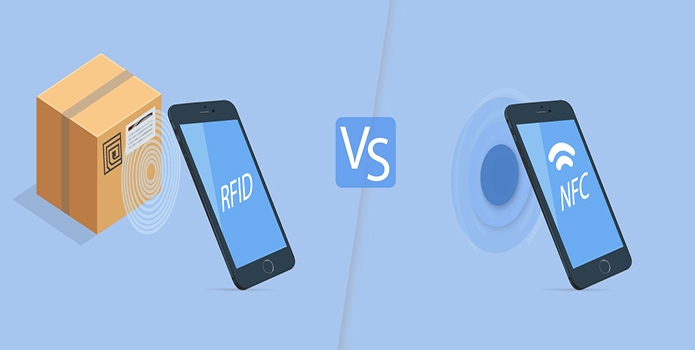The primary difference between RFID and NFC is that NFC works only with short distances (usually less than 10 cm), and it can be powered by capacitive energy transfer.
On the other hand, RFID uses the frequency of 125 kHz/13.56 MHz and requires a power source (battery or induction coil). It offers a maximum range of 100 meters.
Besides these differences, the technologies are pretty similar. This article gives an in-depth comparison between NFC and RFID.
Cos'è l'RFID?
RFID (Radio Frequency Identification) is a wireless non-contact technology that uses electromagnetic fields to transfer data from the Tag (transponder) to the Reader (interrogator).
The two main components of an RFID system are a tag and a reader device, each having an antenna. The transmission medium is the air interface.
It works at very high frequencies (125 kHz/13.56 MHz). As such, it allows large amounts of data to be transferred quickly between two transponders or between a transponder and a reader.
What are the Applications of RFID?
Ci sono molti usi dell'RFID. Può essere utilizzato per coordinare e controllare l'accesso in diversi settori, come impianti industriali o fabbriche. In quanto tali, questi tag possono migliorare la produttività dei processi industriali e ridurre gli sprechi monitorando l'utilizzo di materie prime e prodotti finiti.
È anche utile nella gestione e nel monitoraggio di asset, come camion commerciali o container nei porti o negli aeroporti. In questo modo si evitano perdite causate da furto o maltrattamento.
Ad esempio, se un'azienda dispone di più magazzini, può localizzare le proprie merci ovunque vada semplicemente installando un lettore RFID all'ingresso di ogni magazzino.
La tecnologia RFID può essere utilizzata anche in molti altri settori come:
- Identificazione e controllo degli accessi
- Tracciamento dei veicoli
- Tracciamento di animali/animali domestici,
- Sistemi di pagamento (integrazione con carte di credito) e cellulari
Cos'è l'NFC?
NFC (Near field communication) is a wireless communication technology that allows two electronic devices closely placed (up to 4 cm) to establish communication and exchange data.
It is related to RFID but it works at lower frequencies (13.56 MHz). They allow large amounts of data to be transferred quickly between two transponders almost simultaneously.
NFC is comparable to Bluetooth, Infrared (IR), and Wireless LAN standards. Although each of these technologies has its protocol standard, they all establish communication using electromagnetic fields.
This technology requires short-range, so it is used to create wireless connections between small portable devices such as mobile phones or tablets.
What are NFC Tags?
An NFC tag contains information that different applications can access – usually through an NFC Service ID assigned by the manufacturer, depending on what service this tag will offer.
They have an NFC chip and an antenna embedded in a label or printed directly on a surface. The tag can be read from up to 20 cm (7.9 in) away by an active NFC device such as modern smartphones.
What are the Applications of NFC?
NFC ha diverse applicazioni, incluso il trasferimento di file tra smartphone, sistemi di pagamento, biglietti per i trasporti pubblici e carte di controllo dell'accesso ai contatti.
Inoltre, i lettori NFC possono essere fissati in punti specifici per un rapido trasferimento dei dati. Un esempio di questo sono i bancomat, dove devi toccare la tua carta di credito su un lettore in modo che possa leggere alcune informazioni utili come numero di conto, data di scadenza e codice di sicurezza.
In questo modo, effettuare un acquisto online è sicuro poiché nessuno potrà rubare la tua password o il tuo conto bancario durante il pagamento, a meno che non accedano a quel dispositivo NFC (ATM) che memorizza i tuoi dati bancari.
Un altro applicazione per tag NFC è nella pubblicità. Molte aziende vogliono il loro messaggio là fuori, ma non tutti hanno abbastanza soldi per comprare pubblicità televisive. Queste aziende creano articoli speciali contenenti il logo dell'azienda con un tag NFC incorporato al loro interno, quindi quando qualcuno si avvicina con un cellulare abilitato NFC, il tag verrà scansionato e verrà visualizzato un messaggio.
Tag NFC può anche essere utilizzato per avviare applicazioni o azioni specifiche sul dispositivo. Potresti averlo visto in azione in luoghi pubblici in cui ti viene chiesto di non usare il tuo telefono ma piuttosto di toccarlo contro un lettore.
Un esempio di questo è Google Wallet, dove puoi effettuare acquisti online avvicinando il tuo cellulare a un lettore NFC. Questa azione consente a Google Wallet di trasferire i dati richiesti per completare la transazione.
RFID vs. NFC – What is The Difference?
These technologies work on the same principle: sending and receiving data without any physical contact. While their speeds are very close, RFID is faster for a wide read range while NFC works in a smaller area.
Both RFID and NFC do not require a direct line of sight. As such, you can read the tags from whichever angle you find convenient. This feature makes the tag more reliable and faster compared to barcodes.
However, there are a few differences between RFID and NFC, including:
- Frequency of Operation. NFC operates only at 13.56 MHz while RFID can operate within a frequency range of 134.2 kHz to over 900 MHz.
- Intervallo di lettura. NFC operates optimally when the reader and the tags are a maximum of 10 cm away from each other. This short read range limits NFC to data exchange, contactless payments, and proximity cards. On the other hand, RFID tags can have a read range of up to 100 meters, thus making them ideal for tracking.
- Memory. RFID tags have a larger memory capacity than NFC. The feature makes them useful where you need to store massive amounts of data. Most RFID tags are not writable so it will be hard to change the data on there without erasing everything and writing it again. However, you can get one with write/read abilities.
- Functionality. RFID deals particularly with identification while NFC deals with communication. RFID is ideal for processing large amounts of data within a short time.
Both NFC and RFID are highly reliable. However, you should define your needs before you settle for one. If you need one for identification and access control, then we recommend RFID. If you need one for communication and data exchange, then you should choose NFC.
Articoli correlati
- Come programmare i tag NFC
- Che cos'è il pagamento NFC?
- Telefoni con NFC nel 2021: elenco dei dispositivi mobili abilitati per NFC
- Come utilizzare NFC su iPhone: ecco cosa devi sapere!
- 12 migliori usi di tag NFC che renderanno la tua vita divertente
- NFC vs. RFID: qual è la differenza tra loro?
- Scopra tutto sui diversi tipi di tag RFID
- Guida per principianti - Cos'è un tag NFC?


